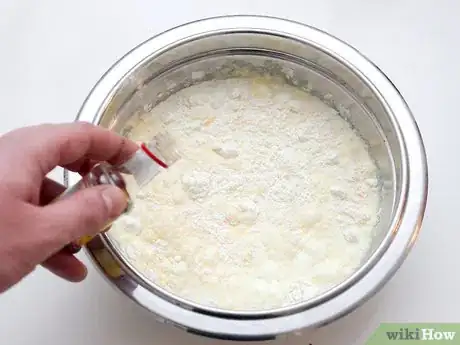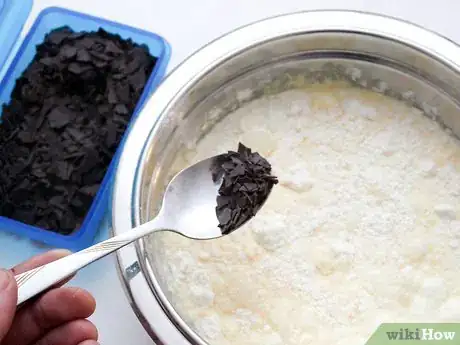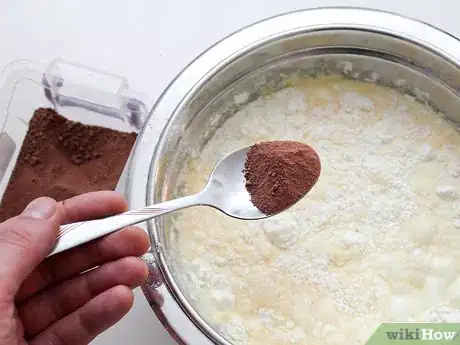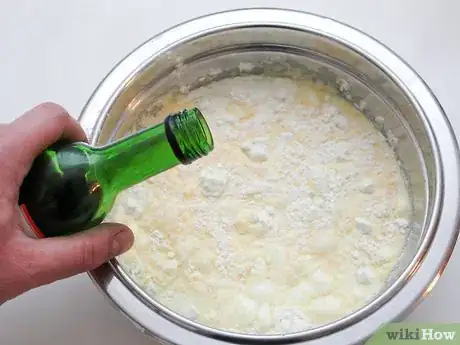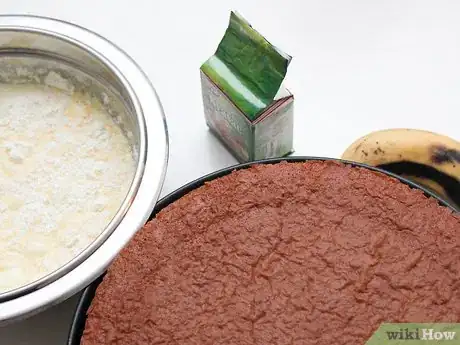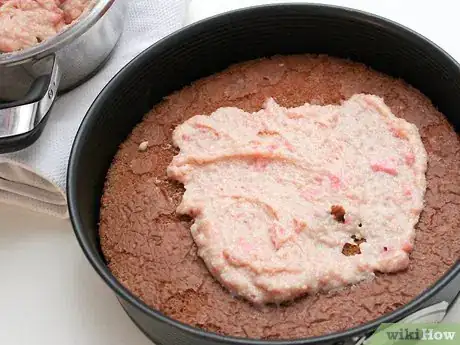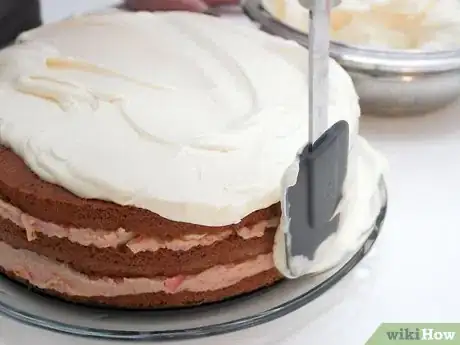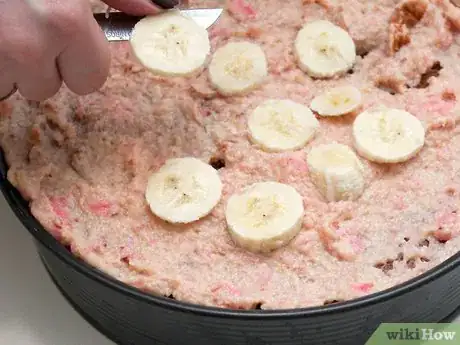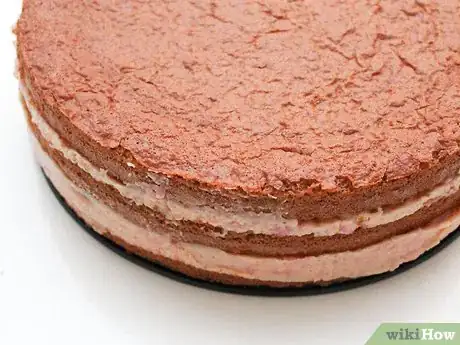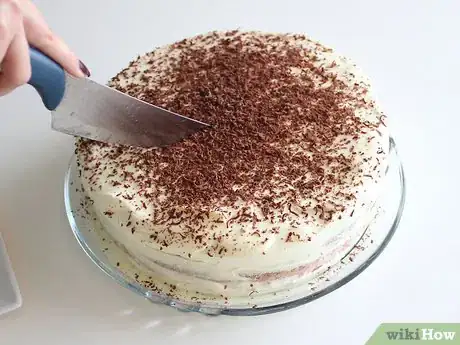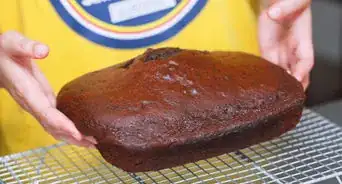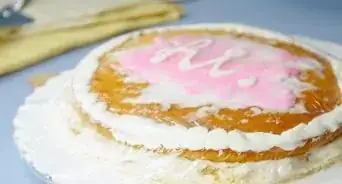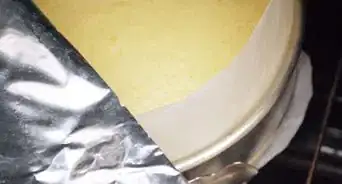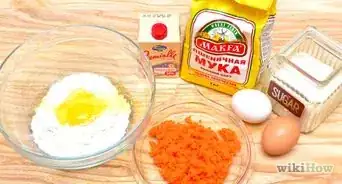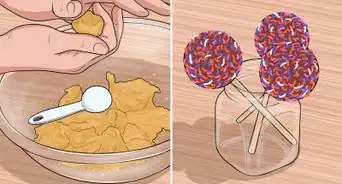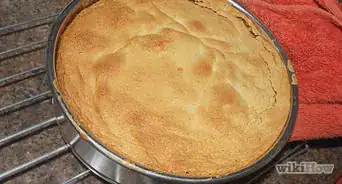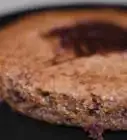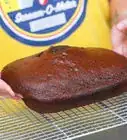wikiHow is a “wiki,” similar to Wikipedia, which means that many of our articles are co-written by multiple authors. To create this article, volunteer authors worked to edit and improve it over time.
This article has been viewed 75,515 times.
Learn more...
Flavoring cake can be an intimidating yet rewarding culinary adventure. There are several ways to alter dull cake mixes and basic cake recipes, so have fun and experiment with a few different options as you search for baked-good-bliss.
Steps
Adding Flavor to Cake Batter
-
1Use extracts and flavorings. Liquid extracts and flavorings are one of the easiest ways to alter the taste of cake batter since they generally have little effect on the other ingredients, moisture level, or density of the cake.
- Extracts are more concentrated than flavorings, so you should generally use less extract than flavoring. Since extracts are more concentrated, however, they typically create richer, more natural tastes.
- To experiment with different extracts, consider starting with a cake recipe that already contains vanilla extract. Replace half of the vanilla with the extract of your choice to introduce a subtle hint of the new flavor.
-
2Mix fresh ingredients into the cake. Adding fresh ingredients to the batter can produce an even stronger taste than using the equivalent extract. Some ingredients will blend into the batter, but others will retain their form even after the cake bakes.
- Melted chocolate is a popular choice, but it can be a difficult ingredient to work with. Since the ingredient is so heavy, you will likely need to balance the extra weight with additional beaten eggs or other raising agents.
- Consider scraping out the inside of a vanilla bean instead of using vanilla extract. As a general rule, 2 inches (5 cm) of vanilla bean equals 1 tsp (5 ml) of vanilla extract.
- Chopped ingredients, like nuts, fruits, or large pieces of chocolate can be used and typically retain their form instead of mixing into the batter. Note that fruit can make cakes more moist, however, since the juices tend to seep into the batter as it bakes.
Advertisement -
3Sift cocoa powder into the batter. Cocoa powder is essentially the dehydrated form of cocoa solids. You can add it to white or yellow cakes to create a strong chocolate flavor or mix it into chocolate cakes to further intensify the taste.
- There are two types of unsweetened cocoa powder: Dutch-processed and natural. The former has a lighter flavor and should be used in cake recipes calling for baking powder or other acidic ingredients. The latter can have an intense, bitter taste and should be used in recipes calling for baking soda.[1]
-
4Try flavored liquids instead of water. For cake mixes and recipes including water, switch out part or all of the water for another liquid that can introduce more flavor to the cake.[2]
- You can generally swap out half to all of the water when using dairy-based or water-based liquids, including brewed coffee, milk, and juice.
- For alcohol-based liquids, however, you should replace no more than half of the water with your liquor or liqueur of choice.
-
5Spice up the batter. Certain spices can add new flavors to the cake or enhance flavors currently used. Some spices are more potent than others, though, so you'll need to vary the amount depending on which one you choose.
- Popular choices include cinnamon, ginger, nutmeg, cloves, and allspice. Of these additions, only cinnamon should be used in relatively large quantities (up to 2 or 3 tsp [10 to 15 ml]). The others tend to be more potent when used in excess.
-
6Add dry pudding mix. Dry instant pudding can add both moisture and flavor to a cake, and it's an especially good option to use when you want to flavor a boxed cake mix.
- Typically, you should use one small box of instant pudding in the flavor of your choice for one standard box of dry cake mix. You may also wish to add an extra egg to help balance out the extra weight since eggs can serve as raising agents.
-
7Enhance the overall flavor with richer ingredients. If you want to produce a richer taste instead of completing altering the flavor profile, switch blander ingredients for more flavorful options or increase the amount you use.
- Instead of using vegetable oil, use equal amounts of melted butter since butter has a richer taste. Depending on the recipe, you might be able to add as much as twice the amount originally called for, but doing so will also introduce more moisture into the cake.
- Consider cracking an extra egg into the batter. Eggs are another ingredient capable of enhancing the tastes already in your batter, and adding an extra egg can also make cakes fluffier.
Adding Flavor to Baked Cake
-
1Pour syrup over the cake. As soon as you pull the cake out of your oven, use a toothpick to poke small holes into the surface and pour or spread hot fruit syrup over the entire top.[3]
- The resulting cake will retain the flavor of the syrup while also becoming more moist.
- For a simple fruit syrup, consider mixing 2 to 3 Tbsp (30 to 45 ml) of any fruit jam or preserve with enough hot water to dissolve it into liquid form.
-
2Spread filling in between layers. If you baked a layer cake, you can add more flavor to each bite by spreading an interesting filling between each separate layer.[4]
- Choose a filling that can hold its form beneath the weight of the cake's upper layers. Buttercream icing is popular, but jams, canned pie fillings, and canned cake fillings also work well.
- For most fillings, you should spread an even 1/4 inch (6 mm) over the top surface of the bottom layer before placing the next layer over it.
-
3Change the frosting. A change in frosting is another easy way to change the overall flavor profile of your cake. You can use prepackaged jars of frosting or mix your own frosting.
- Like cake batter, you can also alter the taste of the frosting using extracts or liquid flavorings. Add the ingredient in small amounts, however, to prevent the frosting from becoming too runny. Moreover, you should also opt for artificial extracts or naturally clear flavorings if you do not wish to tint the final color of the frosting.
Picking Flavors
-
1Experiment with different combinations. Be bold, and don't be afraid to try flavors and flavor combinations you haven't run across before. Departing from the recipe as it's written requires a little culinary courage, but the end result can be well worth it.[5]
- Look for inspiration everywhere and jot down the ideas as they come. Inspiration often strikes when you eat other foods, learn about unique ingredients, or hear about intriguing cakes. Additionally, your sense of smell is connected to your sense of taste, so don't dismiss ideas derived from candles or other pleasant scents, either.
- Experimenting when the pressure is low can also embolden you. Avoid testing new ideas when baking cakes for special occasions and consider halving the recipe to create less waste if your test fails.
-
2Research your idea. If you have an idea but are too scared to take the plunge, do some research before you step into the kitchen. Search on Pinterest or popular recipe websites to determine if anyone else may have combined similar flavors, then read about the methods others have used when doing so.
- Instead of looking for an exact recipe to duplicate, focus on the proportions and ingredients used to produce certain flavors. Doing so can give you an idea of how much to add of which ingredients when you start experimenting with your own cake recipe.
-
3Learn about each ingredient. Baking involves chemistry, and many ingredients you might use to add flavor will also affect the cake in other ways. Before using any particular ingredient, find out if it might impact the cake's density, texture, or ability to rise.
- Counteract unwanted effects by adding other ingredients to balance them out. For instance, cocoa powder adds weight and dryness to a cake, so you would need to add more of your raising agent and more moisture to neutralize these effects.
- Note that you may also need to learn about some of basic ingredients; otherwise, you won't know which ingredients to use when balancing out the negative effects of your flavor additions.
-
4Build the flavor gradually. Since you'll likely end up working with some unfamiliar ingredients and flavor combinations, it's best to start adding new flavors in small amounts.
- This is especially important when you add flavors directly to the batter. You can easily build up weak flavors, but if you accidentally add too much of any one taste, you won't be able to cut that flavor back down.
- After adding each new flavoring ingredient, taste the batter and determine if it needs more. When adding multiple flavors, ask yourself if the flavors balance each other or if you need to alter the proportions further.
-
5Evaluate the finished cake. The baking process can tone down some flavors while drawing out other tastes, so the finished cake may not taste exactly like the batter. For that reason, you'll need to continue evaluating the taste and balance of flavors while biting into the finished cake.
- Be your own critic. Ask yourself if the cake tastes the way you hope it would, and if it doesn't, try to figure out the cause. The flavor combination may not work at all, but oftentimes, the taste can improve with some alterations. It's possible that you added too much or too little of one ingredient. Alternatively, you might decide to swap out one ingredient for another—for instance, melted chocolate for cocoa powder.
- Ask others to critique your cake, as well. Since they didn't bake it, they may not be able to help you alter the recipe for future reference, but they can at least give you an honest opinion about the way it tastes.
Community Q&A
-
QuestionHow can I make a mango cake batter with fresh mangoes? I like a strong flavor.
 Bananabunny999Community AnswerTry adding some mango puree to the batter. If that's not strong enough, try using freeze-dried mangoes. Grind them up a bit in a blender until they turn to powder, then add the mango powder to your batter. Keep the leftover powder away from moisture.
Bananabunny999Community AnswerTry adding some mango puree to the batter. If that's not strong enough, try using freeze-dried mangoes. Grind them up a bit in a blender until they turn to powder, then add the mango powder to your batter. Keep the leftover powder away from moisture. -
QuestionCan I use coffee to flavor the cake?
 Community AnswerYes, you can use coffee to flavor your cake. Baking requires careful measurements, so for best results, find a recipe for a coffee flavored cake or be prepared to tweak your recipe a few times before you get one you're happy with.
Community AnswerYes, you can use coffee to flavor your cake. Baking requires careful measurements, so for best results, find a recipe for a coffee flavored cake or be prepared to tweak your recipe a few times before you get one you're happy with. -
QuestionCan I add strawberry jam to a cake mix?
 MrExpertCommunity AnswerNo. It would ruin the texture and consistency, as well as cause the baking time to increase.
MrExpertCommunity AnswerNo. It would ruin the texture and consistency, as well as cause the baking time to increase.
References
- ↑ http://www.joyofbaking.com/cocoa.html
- ↑ http://www.huffingtonpost.com/2012/12/14/cake-mix-better-improve_n_2294219.html
- ↑ https://www.thekitchn.com/how-to-flavor-a-cake-with-jam-79963
- ↑ http://www.wilton.com/blog/index.php/fill-your-cakes-with-flavor/
- ↑ http://www.craftsy.com/blog/2014/07/ideas-for-flavoring-cakes/
About This Article
There are countless ways you can flavor a cake, depending on what mood you’re in. When you’ve mixed your cake batter, you can add an extract like vanilla, almond, maple, or butterscotch. You can also mix in fresh ingredients like nuts, dried fruit, orange zest, and chocolate pieces. For a lighter cake, mix in cocoa powder instead of chocolate. Or, add your favorite spice, like cinnamon, ginger, or nutmeg. Another way to flavor your cake is to exchange all or part of the water in the recipe for brewed coffee, milk, or juice. For more tips, including how to flavor your cake’s icing, read on!
